- | 5:00 pm
How Hermès conquered the luxury industry
Hermès eschews trends and embraces old-fashioned craftsmanship—and has seen its revenue climb.
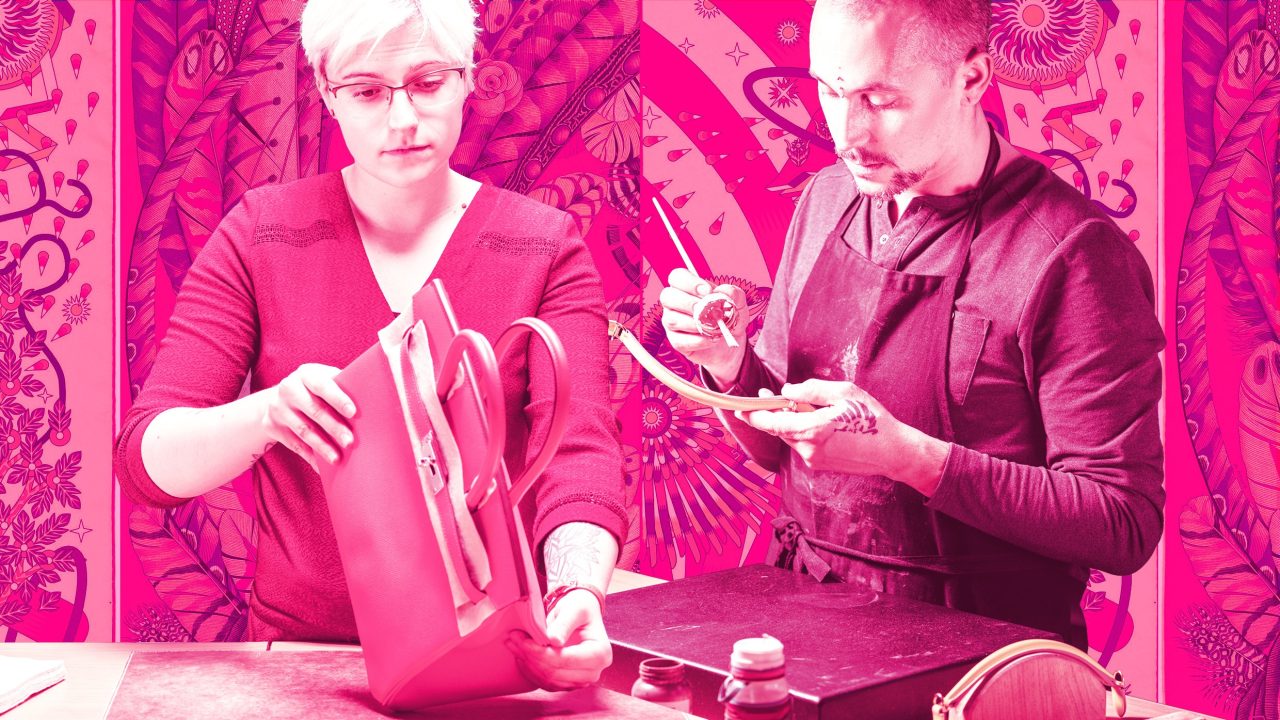
Hermès’s largest factory, in the sleepy Paris suburb of Pantin, is a stunning structure with glass walls. Light dapples the workstations where artisans handcraft Birkin and Kelly bags that will sell for upward of $10,000. But Axel Dumas, Hermès’s CEO, has a soft spot for the smaller, humbler workshop around the corner, where customers send in decades-old, weather-beaten Hermès products to be repaired.
It takes years of training for an Hermès leatherworker to qualify to work in the restoration department, since the work is more complex and delicate than building a bag from scratch. When I visited the workshop before the pandemic, I saw a camel-colored briefcase arrive in tatters, covered in splotchy water marks—one of 100,000 pieces that passed through the workshop in 2019. The man repairing the bag quickly identified it as a model from the 1970s and took apart stitches to remove a stained strip of leather. His colleague dug through a pile of cowhides to find one that perfectly matches the bag’s creamy, glistening patina. “There’s nothing that makes me happier than when a young girl comes to us with her grandmother’s handbag and asks us to give it new life,” Dumas says, a member of the sixth generation of his family to lead the company.
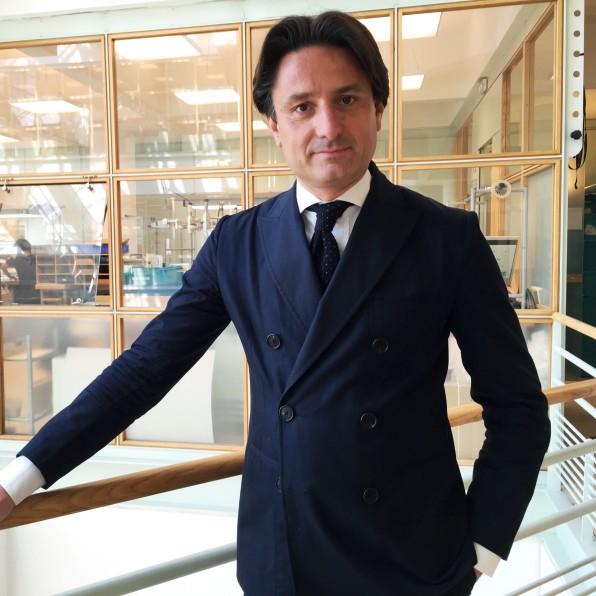
Hermès CEO Axel Dumas [Photo: Jane Evelyn Atwood]
Hermès has offered repair services since Thierry Hermès established the company in 1837 as a purveyor of saddles and horse harnesses. Nearly two centuries later, Hermès’s approach to creating durable, well-crafted goods that are designed to be passed from one generation to the next is resonating with consumers, particularly those who are concerned about the planet, according to Dumas. While other luxury houses have courted younger shoppers by appointing hip creative directors with a knack for eye-catching aesthetics, Hermès has largely stayed true to its classic designs—with the occasional concession to trends, such as the $5,000 fanny pack it released in 2019. But the brand has made its traditional craftsmanship and iconic bags feel new through pop-ups and art installations that allow it to highlight both its commitment to durability and the enduring value of its products.
All of this comes down to Hermès’s skill at winning over a new generation of consumers, not by reinventing itself, but by hewing closely to its original mission of selling handmade goods, designed to last forever. But as the brand continues to conquer the luxury industry, it will have to reckon with a paradox at the heart of its business model: How can it continue to grow when its success and sustainability are premised on scarcity?
NOT YOUR GRANDMOTHERS’ HERMÈS
During Austin’s South by Southwest festival three years ago, I took a walk on South Congress Avenue, where I stumbled across a laundromat with washing machines in a precise shade of Hermès orange. I looked closer and discovered that it was, in fact, an Hermès pop-up offering a free service: People could bring in their vintage Hermès scarves to be updated using a dip-dyeing technique that would give them vibrant new colors.
Hermèsmatic, as the installation was called, appeared all over the country—New York City, Nashville, Tennessee, Washington, D.C.—as well as in Manchester, England, and Istanbul, Turkey. To Dumas, part of the point of the pop-up was to prove that focusing on durability doesn’t have to be boring. “After we invest so much in our product, in the fabrication, in the quality of the material, we like to be a bit playful,” Dumas says. “We’re fun people here, inside the company, and we try to express that. Whenever we think about doing a new project, the thing I ask myself is: Will it make us laugh?”
The immersive, Instagrammable experience was perfectly pitched at younger consumers, but it also drove home the point that even the most delicate Hermès products, such as the iconic silk square, are designed to last forever. And ingeniously, it made the case that buying a brand-new $435 Hermès scarf was a good investment.
Dumas says his family has always been maniacally focused on making high-quality, long-lasting products but that message has not always been attractive to consumers. He first joined the company in 2003, at a time when it was fashionable to wear flashy designer outfits covered in enormous logos, making Hermès’s classic designs and inconspicuous branding seem staid. Part of the brand’s current success, he believes, is simply that many people’s values have shifted to align with those of Hermès. “Back then, consumers were all about bling-bling,” says Dumas, with a laugh. “Our ethos didn’t work as well back then. Today, consumers care about whether an object can last a long time and not contribute to waste.”
Of course, it’s easier to encourage people to hold onto products for life when they are extremely expensive, which is the case with Hermès. At the high end, Birkin bags can run upwards of $100,000. The brand woos younger consumers with entry-level products such as scarves, bracelets, and sneakers, which run between $400 and $800. Prices like this keep the brand exclusive, allowing it to grow without losing its cachet. But Hermès also strategically limits how many of its products it releases into the market. “Our strategy of keeping a very limited distribution has really worked very much in our favor,” Robert Chavez, Hermès’s president and CEO for the Americas, explained at a 2019 conference. “People want things that not a lot of people can get; once something becomes very very saturated, that luxury consumer doesn’t really want that anymore.”
Hermès deliberately makes it hard for consumers to access some of its most coveted bags, such as the Birkin and the Kelly. You can’t buy these items online, and since the brand no longer offers waiting lists through its stores, you need to have an existing relationship with Hermès to buy one. Owning one of these bags signals wealth, but also your ability to get behind the velvet rope the brand has erected. Scarcity also means these bags retain their value on secondhand markets. According to resale site Rebag’s annual report, Hermès bags fetch 80% of their retail price when resold, while Chanel and Louis Vuitton only fetch 63%.
But there is an inherent paradox to growing by maintaining exclusivity. As the brand’s increasing revenue demonstrates, more people around the world now own Hermès goods. The company is expanding its production capacity to meet this demand: This year, it will unveil a new leather-goods workshop staffed by 250 artisans, with more production centers coming in the next two years. After Hermès’s most recent earnings call, Bernstein luxury analyst Luca Solca pointed out in a memo that increasing volume could reduce the brand’s desirability in the long term. “Failure to convincingly innovate could push Hermès in a ‘classic corner,’ out of sync with younger global luxury consumers,” he wrote.
THE OVERCONSUMPTION PROBLEM
Over the past five years, fashion has started to reckon with its devastating impact on the planet. The industry is responsible for 1.4 million trillion microplastic fibers in the ocean and 20% of global wastewater. It accounts for between 4% and 10% of global carbon emissions, depending on your calculation. But studies show that consumers are eager to make more conscious purchases, which is why products marketed as eco-friendly are growing faster than their conventional counterparts.
The fashion industry now sees the economic opportunity of marketing greener goods. Startups such as Allbirds and Pangaia have developed eco-friendly materials for products, and Adidas and Everlane are trying to eliminate virgin plastic from their supply chain. In the luxury sector, Gucci is now carbon neutral through investments in regenerative farming and biodiversity, and Stella McCartney uses cutting-edge materials, such as lab-grown leather and bioengineered silk. But these efforts won’t put a dent in luxury’s environmental footprint if the industry keeps churning out so many products.
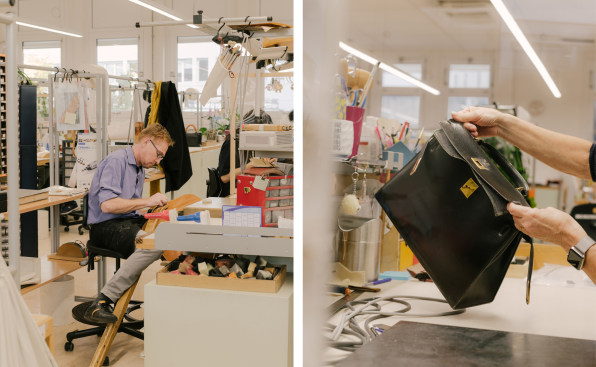
An Hermès repair workshop [Photos: Maxime Verret]
Hermès has taken a different approach to sustainability. Dumas firmly believes that one of the biggest problems in the fashion industry is overconsumption: Between 2000 and 2015, the number of garments produced globally doubled from 50 billion to 100 billion, for only 7.8 billion humans. He argues that one of the most powerful ways to combat fashion’s impact on the planet is to encourage consumers to own less—and one way to do this is to help them repair what they already have. “Offering long-lasting, repairable objects, which are meant to be handed down, is also a way to reduce the impacts of overconsumption and wasting of resources, one of the principles to which Maison Hermès is particularly attached,” the brand’s 2019 financial report reads.Hermès invests in creating buzz around activations such as Hermèsmatic, and it even produced a documentary-style video series on YouTube to highlight its repair workshop. As the brand grows, so do its repair operations: It currently employs 78 specialists in 14 workshops across the United States, Asia, and Europe, and it has just opened a new repair shop in New York City. Dumas says all of this is designed to encourage Hermès customers to keep products for a lifetime but also to create a culture where fashion items are seen as durable.
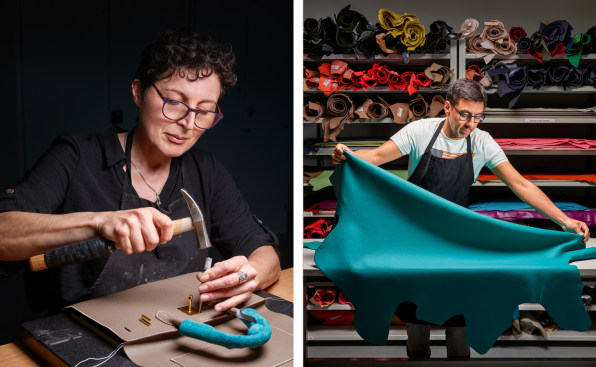
An Hermès leather-goods workshop [Photos: Chris Payne]
Hermès is also working to reduce its impact across its supply chain by eliminating carbon emissions and offsetting the rest through large reforestation efforts around the world. It’s worth pointing out, though, that half of the company’s revenue comes from leather goods, and raising cattle is particularly bad for the planet: Cows generate 40% of the world’s methane, a greenhouse gas that is 28% more damaging to the climate than carbon dioxide. This is why tech companies such as Bolt Threads and Natural Fiber Welding are so invested in creating more sustainable alternatives.
Dumas says that since the company only uses natural fabrics such as leather, silk, and cashmere, and sources the highest-quality (and thus most expensive) materials available, the company is invested in protecting these resources and maximizing their use. Hermès works closely with its partner farmers and tanneries to operate sustainably, partly out of self-interest. In Brazil, for instance, the company has spent two decades working with local farmers to cultivate mulberry trees using traditional Japanese methods, which, in turn, feed silkworms. This supply chain produces the highest-grade silk, but it is currently under threat because of climate change. “We are a bit like the canary in the coal mine,” Dumas says. “What is happening to the environment is very worrisome for our business model because we’ve seen a decrease in the quality of materials over the last five years. Farming is more industrialized than before, and this is really having an impact [on our access to materials].”
SUSTAINABILITY CAN BE BEAUTIFUL
As I stepped out of Hermès’s restoration department in Paris and meandered through the rest of the building, I stumbled into another workshop that felt like a magical alternate universe. Here, workstations were covered in colorful curiosities: swaths of silk, leather scraps, and jars full of buttons. I nearly ran into a life-size sculpture of a mother and baby hippo made from blue leather. I had stepped into Petit H, a studio where craftspeople create one-of-a-kind objects from materials salvaged from Hermès factories.
Petit H first launched in 2010 as part of the company’s commitment to sustainability. In 2020, France passed a law forbidding brands to destroy unsold products, making Petit H’s mission even more relevant. Godefroy de Virieu, Petit H’s creative director, points out that the studio has developed a process for deconstructing unsold items and turning them into new products. Some items are sold in Hermès stores, while larger, rarer ones are sold at auctions in art exhibits that pop up around the world. All of this generates another revenue stream for the company.
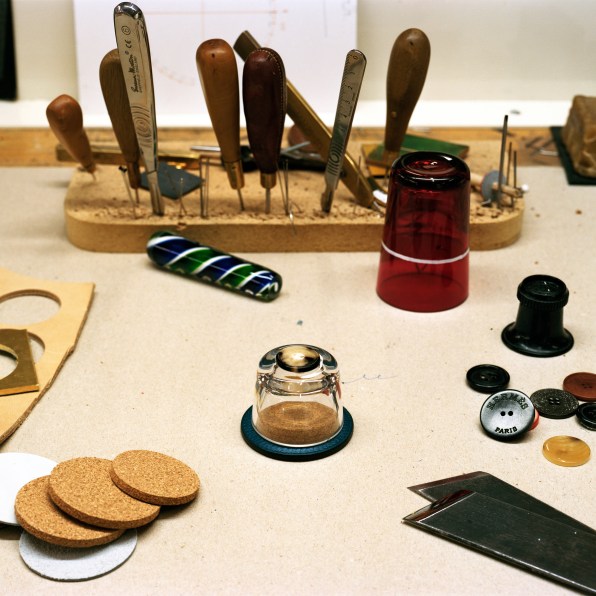
Petit H [Photo: Alexandre Guirkinger]
Seated at their workstations, the craftspeople have autonomy over what they make, but given how small most of the scraps are, many of the products are small and quirky. I spot a leather beer cozy, charms in the shape of hearts, miniature dogs wrapped in leather, silk pouches made from scarves that were never sold, and coin purses and wallets. “What we do here is bricolage,” says de Virieu. “It’s a way of showing our customers that nothing is wasted at Hermès.” Petit H represents a new chapter for Hermès, but in many ways, it simply reprises the themes the company has continually returned to over the last 184 years: sourcing the best raw materials, maximizing their use, and handcrafting them into durable products.
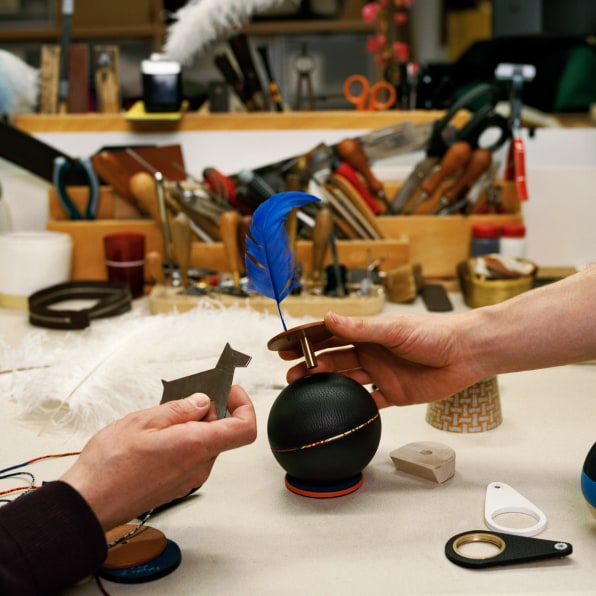
[Photo: Alexandre Guirkinger]
The question now is how Hermès will continue to grow—and sell more products—while retaining its exclusivity and commitment to sustainability. Anita Radon, a business professor at the Swedish university Södertörn who specializes in luxury brands, says that balancing growth with scarcity has always been the central challenge of the luxury sector. It becomes trickier as brands expand into Asia. For Hermès, the struggle is even more acute, since the brand’s success is so explicitly connected to its rarity.Radon says the way to keep consumers hooked as products become more common is to invest heavily in the myths about the brand’s origins: This kind of storytelling can create the aura of exclusivity, even as the products become more widely available. She points to the way Hermès has named its two most famous bags for the iconic women who first carried them, Jane Birkin and Grace Kelly. “True or not, myth or actual history, these little bits of [storytelling] help in keeping up the notion of luxury and exclusivity,” she writes in the Journal of Business Administration Research.
As Dumas helms Hermès through this period of remarkable success—even in the face of a pandemic—he’s clearly thinking about what it means to grow sustainably, in every sense of the word. It’s a very personal question for him; it is, after all, still his family’s business, and he would like to leave it in good shape for the next generation. “When I think about what it means to manage the House of Hermès, I really do think of it as a house,” he says. “How do you build a house with a strong foundation? How do you treat the people in your house? How do you treat the garden next to your house? If there is something that needs to be done better, let’s embrace it.”
For more on Fast Company’s list of the Top 10 Most Innovative Companies in style for 2021, click here.








































